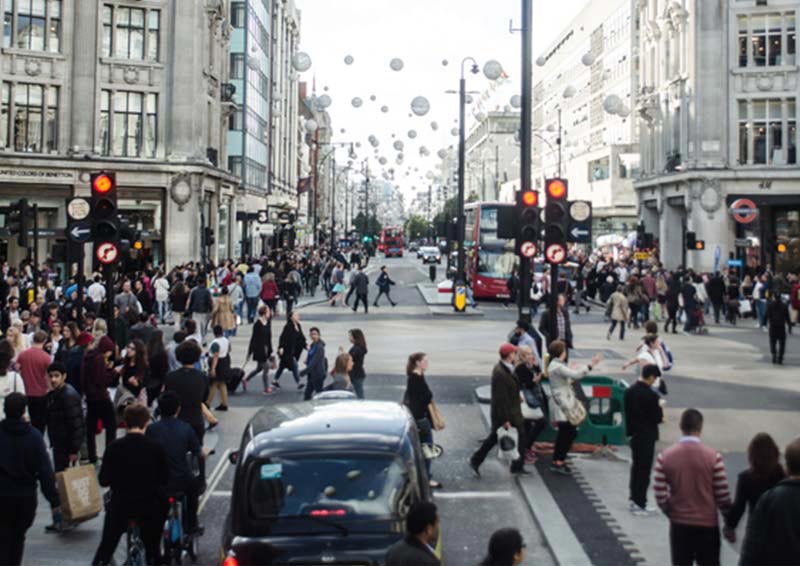People flow
People flow is relatively new term used to describe the movement of pedestrians in different environments under different circumstances and at different scales. The term has perhaps historically been used to refer to the transit of populations between different geographical regions, but has now come to be used also in the context of urban planning, public space and the urban realm as well as circulation within or between buildings.
Whilst the term is less common in formal dictionaries, IGI Global a leading independent academic publisher of scientific research defines the term as "a physical quantity representing the number of people passing through a certain passage per unit time".
An industry perhaps considered as one of the proponents of the term are manufacturers of vertical transport systems such as elevators, lifts or escalators. Increasing the efficiency of such systems relies on an understanding of how occupants move around buildings of more than one levels, but also within individual levels.
In terms of the urban planning people flow might be used synonymously or as a derivation of pedestrian flow, footfall, walkshed, or circulation. It describes how people move around spaces, access areas, interact and occupy those areas, externally and internally.
Within buildings it can be important to know, for example which way people tend to turn when they walk into a shop. It can also be useful in evacuation planning.
As accessibility, security as well as observation technology within cities and buildings increases, the term may also be used in connection with barriers, mobility, public infrasructure, thermal imaging, CCTV, observation, face recognition and Smart cities.
The development of mobile devices has made it easier to track people flow, for example by offering free wifi, the terms and conditions of which allow operators to record subscriber's locations.
[edit] Related articles on Designing Buildings
- 15 minute city.
- Built environment.
- Cycling and walking plan.
- Designing for pedestrians.
- Desire lines.
- Space syntax.
- Pedestrian amenity
- Pedestrian priority street
- Pedestrian zone
- Pedestrianised.
- Psychogeography.
- Public space.
- Walking distance.
- Hub and spoke model.
- Landscape urbanism.
- Pedestrian..
[edit] External links
Featured articles and news
RTPI leader to become new CIOB Chief Executive Officer
Dr Victoria Hills MRTPI, FICE to take over after Caroline Gumble’s departure.
Social and affordable housing, a long term plan for delivery
The “Delivering a Decade of Renewal for Social and Affordable Housing” strategy sets out future path.
A change to adoptive architecture
Effects of global weather warming on architectural detailing, material choice and human interaction.
The proposed publicly owned and backed subsidiary of Homes England, to facilitate new homes.
How big is the problem and what can we do to mitigate the effects?
Overheating guidance and tools for building designers
A number of cool guides to help with the heat.
The UK's Modern Industrial Strategy: A 10 year plan
Previous consultation criticism, current key elements and general support with some persisting reservations.
Building Safety Regulator reforms
New roles, new staff and a new fast track service pave the way for a single construction regulator.
Architectural Technologist CPDs and Communications
CIAT CPD… and how you can do it!
Cooling centres and cool spaces
Managing extreme heat in cities by directing the public to places for heat stress relief and water sources.
Winter gardens: A brief history and warm variations
Extending the season with glass in different forms and terms.
Restoring Great Yarmouth's Winter Gardens
Transforming one of the least sustainable constructions imaginable.
Construction Skills Mission Board launch sector drive
Newly formed government and industry collaboration set strategy for recruiting an additional 100,000 construction workers a year.
New Architects Code comes into effect in September 2025
ARB Architects Code of Conduct and Practice available with ongoing consultation regarding guidance.
Welsh Skills Body (Medr) launches ambitious plan
The new skills body brings together funding and regulation of tertiary education and research for the devolved nation.
Paul Gandy FCIOB announced as next CIOB President
Former Tilbury Douglas CEO takes helm.
UK Infrastructure: A 10 Year Strategy. In brief with reactions
With the National Infrastructure and Service Transformation Authority (NISTA).
























Comments
[edit] To make a comment about this article, or to suggest changes, click 'Add a comment' above. Separate your comments from any existing comments by inserting a horizontal line.